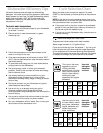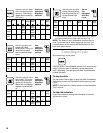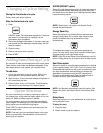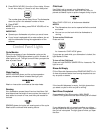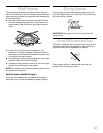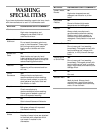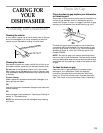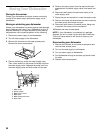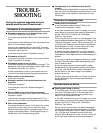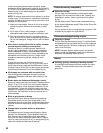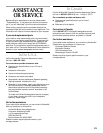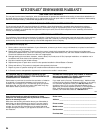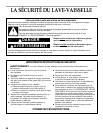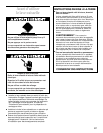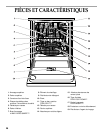
21
TROUBLE-
SHOOTING
First try the solutions suggested here and
possibly avoid the cost of a service call...
Dishwasher is not operating properly
■
■■
■
Dishwasher does not run or stops during a cycle
Is the door closed tightly and latched?
Is the right cycle selected? Refer to the “Cycle Selection
Chart.”
Is there power to the dishwasher? Has a household fuse
blown or circuit breaker tripped?
Has the motor stopped due to an overload? The motor
automatically resets itself within a few minutes. If it does
not restart, call for service.
Is the water shut-off valve (if installed) turned on?
■
■■
■
Dishwasher will not fill
Is the overfill protection float able to move up and down
freely? Press down to release.
■
■■
■
Dishwasher seems to run too long
Is the water supplied to the dishwasher hot enough? The
dishwasher runs longer while heating water. Refer to the
“Dishwasher Efficiency Tips” section.
A delay automatically occurs in some wash and rinse
cycles until the water reaches the proper temperature.
■
■■
■
Water remains in the dishwasher
Is the cycle complete?
■
■■
■
Detergent remains in the covered section of the
dispenser
Is the cycle complete?
Is the detergent lump-free? Replace detergent if
necessary.
■
■■
■
White residue on the front of the access panel
Was too much detergent used? Refer to the “Detergent
Dispenser” section.
Is the brand of detergent making excess foam? Try a
different brand to reduce foaming and eliminate buildup.
■
■■
■
Odor in the dishwasher
Are dishes washed only every 2 or 3 days? Run a rinse
cycle once or twice a day until you have a full load.
Does the dishwasher have a new plastic smell? Run a
vinegar rinse as described in “Spotting and filming on
dishes” later in this Troubleshooting guide.
■
■■
■
Condensation on the kitchen counter (built-in
models)
Is the dishwasher aligned with the counter top? Moisture
from the vent in the dishwasher console can form on the
counter. Refer to the Installation Instructions for more
information.
Dishes are not completely clean
■
■■
■
Food soil left on the dishes
Is the dishwasher loaded correctly? Refer to the
“Loading Your Dishwasher” section.
Is the water temperature too low? If needed, turn home
water heater up to ensure water entering dishwasher is
at least 120°F (49°C). Refer to the “Dishwasher
Efficiency Tips” section.
Did you use the correct amount of fresh detergent? Use
recommended dishwasher detergents only. Refer to the
“Detergent Dispenser” section. Never use less than 1 tb
(15 g) per load. Detergent must be fresh to be effective.
Store detergent in a cool, dry area. Heavy soil and/or
hard water generally require extra detergent.
Is detergent caked in dispenser? Use fresh detergent
only. Do not allow detergent to sit for several hours in a
wet dispenser. Clean dispenser when caked detergent is
present.
Is the pump or spray arm clogged by labels from bottles
and cans? Remove labels before washing bottles and
cans or wash by hand.
Is the home water pressure high enough for proper
dishwasher filling? Home water pressure should be 20
to 120 psi (138 to 828 kPa) for proper dishwasher fill. A
booster pump on the water supply can be added if
pressure is too low.
Are high suds slowing the wash arm? Never use soap or
laundry detergents. Use recommended dishwasher
detergents only.
Spots and stains on dishes
■
■■
■
Spotting and filming on dishes
Is your water hard or is there a high mineral content in
your water? Conditioning the final rinse water with a
liquid rinse aid helps eliminate spotting and filming.
Keep the rinse aid dispenser filled.
Is the water temperature too low? If needed, turn home
water heater up to ensure water entering dishwasher is
at least 120°F (49°C). Refer to the “Dishwasher
Efficiency Tips” section.
Did you use the correct amount of effective detergent?
Use recommended dishwasher detergents only. Refer to
the “Detergent Dispenser” section. Never use less than
1 tb (15 g) per load. Detergent must be fresh to be
effective. Store detergent in a cool, dry area. Heavy soil
and/or hard water generally require extra detergent.



